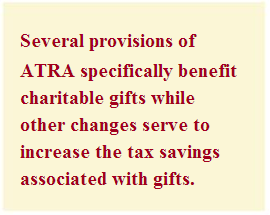Editor’s note: See the January issue of Give & Take for a full summary of the legislation. Highlights of the bill are listed below, as well as any anticipated impact on giving for the remainder of the year and beyond.
On Jan. 2, 2013, President Obama signed the American Taxpayer Relief Act of 2012 (ATRA) into law as part of bipartisan negotiations to avoid the so-called fiscal cliff.
Gift planners and donors will be glad to learn that various proposals that would have directly capped or limited charitable deductions were not included in the legislation. In fact, several provisions of ATRA specifically benefit charitable gifts while other changes serve to increase the tax savings associated with gifts.
The Pease Limitation
There was initially widespread concern over the return of the “Pease Limitation,” which reduces the itemized deductions of higher-income taxpayers.
Theoretically, the return of the “deduction reduction rule” could cause the loss of up to 80 percent of a taxpayer’s itemized deductions.

As a practical matter, fundraisers are beginning to realize this adjustment should have little or no effect on charitable gifts. The impact of the reduction is in most cases absorbed by deductions such as mortgage interest, property taxes or state taxes. The “deduction reduction” will occur in almost all cases whether or not gifts are made. As a result, charitable contributions will remain fully deductible in practice. For more on this topic, see Robert Sharpe’s white paper on the subject, “Overview of the Philanthropic Impact of the ‘American Taxpayer Relief Act of 2012,’” atsharpenet.com/resources.
Higher tax rates
Those in higher income ranges may also find their maximum income and capital gains tax rates have increased along with the new-for-2013 3.8 percent Medicare contribution tax on unearned income. Donors in these tax brackets will be pleased to discover that their higher tax rates will translate into more tax savings than they previously enjoyed when they make their charitable gifts. Charitable gifts remain 100 percent deductible for federal estate tax purposes as well.
From a tax-planning standpoint, the higher your tax bracket, the more you save. Arranging gifts in ways that generate deductions and avoid or bypass capital gains taxes or the Medicare contribution tax simply makes good sense.
For example, by contributing highly appreciated stock, a taxpayer receives a charitable deduction for the full fair market value and pays no capital gains tax or Medicare tax on the appreciation, while also minimizing any loss of itemized deductions. This is possible because gifts of stock are not a sale. No capital gains or Medicare contribution tax is due on the transfer, and the donor’s adjusted gross income is not increased. This in turn results in less of a reduction in itemized deductions under the Pease Amendment.
The charitable IRA provision
Perhaps the best news under the new tax law is the extension of the charitable IRA provision through the end of this year. IRA owners over 70½ may direct gifts of up to $100,000 to qualified charities on a tax-free basis. Funds transferred in this manner count toward required minimum distributions, and donors do not have to itemize to benefit from this type of gift.
Not having to report the distributions keeps the funds from being taxed and also avoids other adverse effects that could result from increasing one’s AGI, such as the taxation of Social Security benefits or a reduction in personal exemptions and allowable itemized deductions.
While no one knows for sure what the future will bring, ATRA preserves and increases the benefits for charitable gifts. This is certainly good news for gift planners and donors in 2013.

